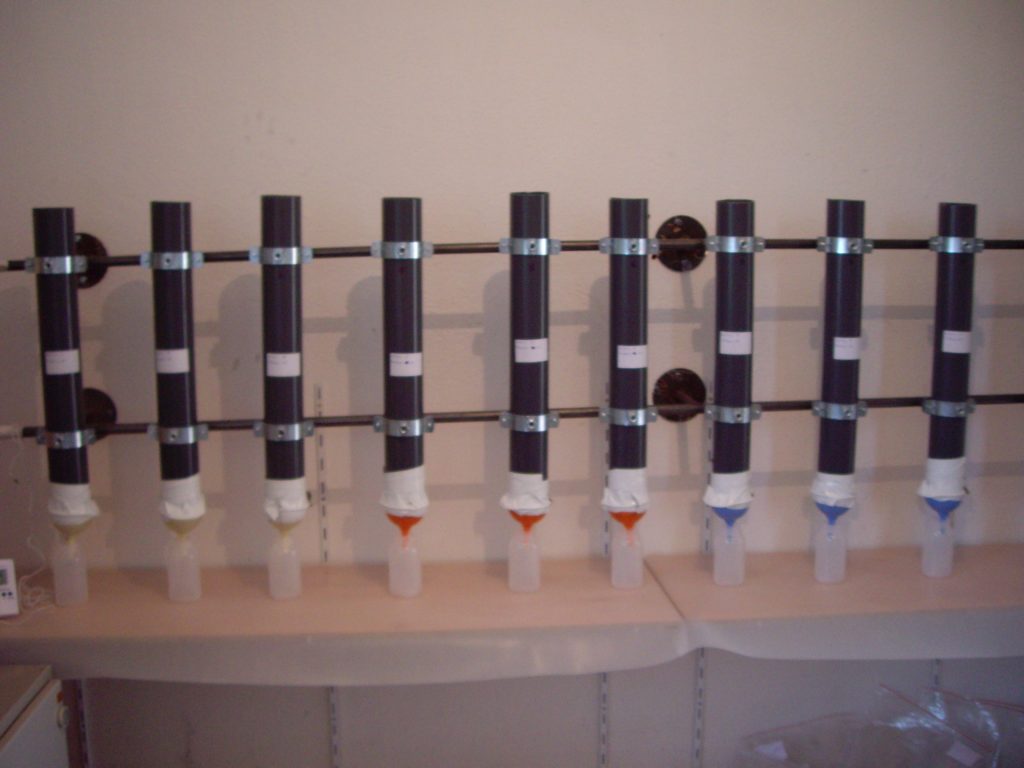Pesticides are common contaminants of natural water resources. After its introduction in soil pesticides dissipation is controlled by basic processes including degradation, biotic or abiotic, adsorption, volatilization and leaching. Currently, pesticide risk assessment is based on the application of mathematical models whose estimation are strongly dependent on the selection of the correct input parameters describing basic processes. Therefore, there is a need for high quality degradation and adsorption data which will be used as inputs for the estimation of environmental exposure. Our group has long standing experience on studying the contribution of different process on the environmental fate of pesticides. This determined through classic aerobic soil degradation studies, soil adsorption/desorption studies, leaching column studies and radiorespirometry mineralization studies in soil.

Funding
- Research Project PYTHAGORAS II, Study of the environmental fate, efficacy and ecotoxicity of the organophosphorus nematicide fosthiazate, Funding: General Secretariat of Research and Technology, Greece. Duration 1/1/2004 – 30/10/2007
- HCPA project. Water protection Best Management Practices establishment emphasizing in Vegetative Buffer Strips: Feasibility demonstration, in Thessaly, Central Greece – Funding: Hellenic Crop Protection Association, Duration: 6.2015-6.2018
- Industrial project, Title: Estimation of the adsorption/desorption of a soil insecticide.
Publications
- Papadopoulou-Mourkidou, E., Karpouzas, D.G. Patsias, J., Kotopoulou, A., Milothridou, K., Kintzikoglou, K., and Vlachou, P., (2004). The potential of pesticides to contaminate the groundwater resources of the Axios river basin in Macedonia, Northern Greece. Part I. Monitoring study in the north part of the basin. Science Total Environment 321: 127-146.
- Papadopoulou-Mourkidou, E., Karpouzas, D.G. Patsias, J., Kotopoulou, A., Milothridou, K., Kintzikoglou, K., and Vlachou, P., (2004). The potential of pesticides to contaminate the groundwater resources of the Axios river basin. Part II. Monitoring study in the south part of the basin. Science Total Environment 321: 147-164.
- Tsiropoulos, N.G., Lykas, D.T., Karpouzas, D.G. (2005) Liquid chromatographic determination of fosthiazate residues in environmental samples and application of the method to a fosthiazate field dissipation study. Journal of AOAC International 88 (6), 1827-1833
- Ferrari, F., Karpouzas, D.G., Trevisan, M., Capri, E. (2005). Predicting and measuring the environmental concentration of pesticides in air after application to paddy water systems. Environmental Science and Technology 39 (9), 2968-2975.
- Karpouzas, D.G., Ferrero A, Vidotto F, Capri E. (2005). Application of the RICEWQ-VADOFT model for simulating the environmental fate of pretilachlor in rice paddies. Environmental Toxicology & Chemistry 24 (4), 1007-1017.
- Karpouzas, D.G., Capri, E. and Papadopoulou-Mourkidou, E. (2006) Basin-scale risk assessment in rice paddies: An example based on the Axios river basin in Greece. Vadose Zone Journal 5 (2) 273-282.
- Karpouzas, D.G., Cervelli, S, Watanabe H, Capri E, and Ferrero A. (2006) Pesticide exposure assessment in rice paddies in Europe: a comparative study of existing mathematical models. Pest Management Science 62 (7), 624-636.
- Karpouzas, D.G., Riparbelli C., Pastori, M., Capri, E. (2006) Landscape risk analysis of pesticides applied to rice paddies. Agronomy for Sustainable Development 26: 167-177.
- Pantelelis, I. Karpouzas, D.G., Menkissoglu-Spiroudi, U., and Tsiropoulos, N.G. (2006). Influence of soil physicochemical and biological properties on the degradation and adsorption of the nematicide fosthiazate. Journal of Agricultural and Food Chemistry 54: 228-237
- Karpouzas, D.G., Pantelelis I., Menkissoglu-Spiroudi U., Tsiropoulos, N.G., Golia E., (2007). Leaching of the organophosphorus nematicide fosthiazate. Chemosphere 68: 1359-1364
- Capri, D.G. Karpouzas (2008). Pesticide risk assessment in rice paddies: Theory and Practice, Elsevier BV, Amsterdam, The Netherlands, ISBN: 978-0-444-53087-5.
- Karpouzas, D.G., and Miao, Z. (2008). Higher tier exposure assessment in rice paddy areas: a European perspective. In Pesticide risk assessment in rice paddies: Theory and Practice, Capri E., and D.G. Karpouzas Eds., Elsevier BV , The Netherlands, ISBN: 978-0-444-53087-5, pp. 125-164.
- Dolaptsoglou, C., Karpouzas, D.G., Menkissoglu-Spiroudi, U., Eleftherohorinos I., and Voudrias, E.A (2009). Influence of different organic amendments on the leaching and dissipation of terbuthylazine in a column and a field study. Journal of Environmental Quality 38: 782-791
- Tsohatzis E., Karpouzas D.G., Menkissoglu-Spiroudi, U, Tzimou-Tsitouridou R (2010) A multi-residue method for pesticide residue analysis in rice grains using matrix solid phase dispersion extraction and high performance liquid chromatography - diode array detection. Analytical and Bioanalytical Chemistry 397: 2181-2190
- Tsohatzis E.D., Tzimou-Tsitouridou R., Menkissoglu-Spiroudi U., Karpouzas D.G., Papageorgiou M. (2012) Development and validation of an HPLC-DAD method for the simultaneous determination of most common rice pesticides in paddy water systems. International Journal of Environmental and Analytical Chemistry 92(5): 548-560
- Tsohatzis E.D., Tzimou-Tsitouridou R Menkissoglu-Spiroudi, U, Karpouzas D.G., Katasantonis D. (2013) Dissipation of tricyclazole, profoxydim and penoxsulam in rice paddy systems: Laboratory and field studies. Chemosphere 91(7): 1049-1057
- Storck V., Lucini L., Mamy L., Ferrari F., Papadopoulou E.S., Nikolaki S., Karas P.A., Servien R., Karpouzas D.G., Trevisan M., Benoit P., Martin-Laurent F., (2016) Identification and characterization of tebuconazole transformation products in soil by combining suspect screening and molecular typology. Environmental Pollution 208: 537-546
- Papadopoulou E., Karas P., Nikolaki S., Storck V., Ferrari F., Trevisan M., Martin-Laurent F., Karpouzas D.G.,(2016) The dissipation and adsorption of isoproturon, chlorpyrifos, tebuconazole and of their main metabolites: A lab-to-field assessment. Science of the Total Environment 569-570:86-96
Personnel
- Dr Panagiotis Karas, Postdoctoral fellow